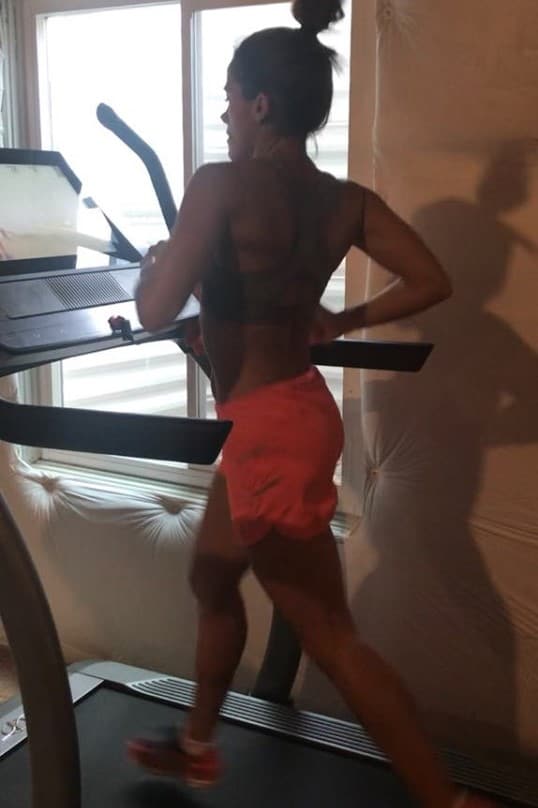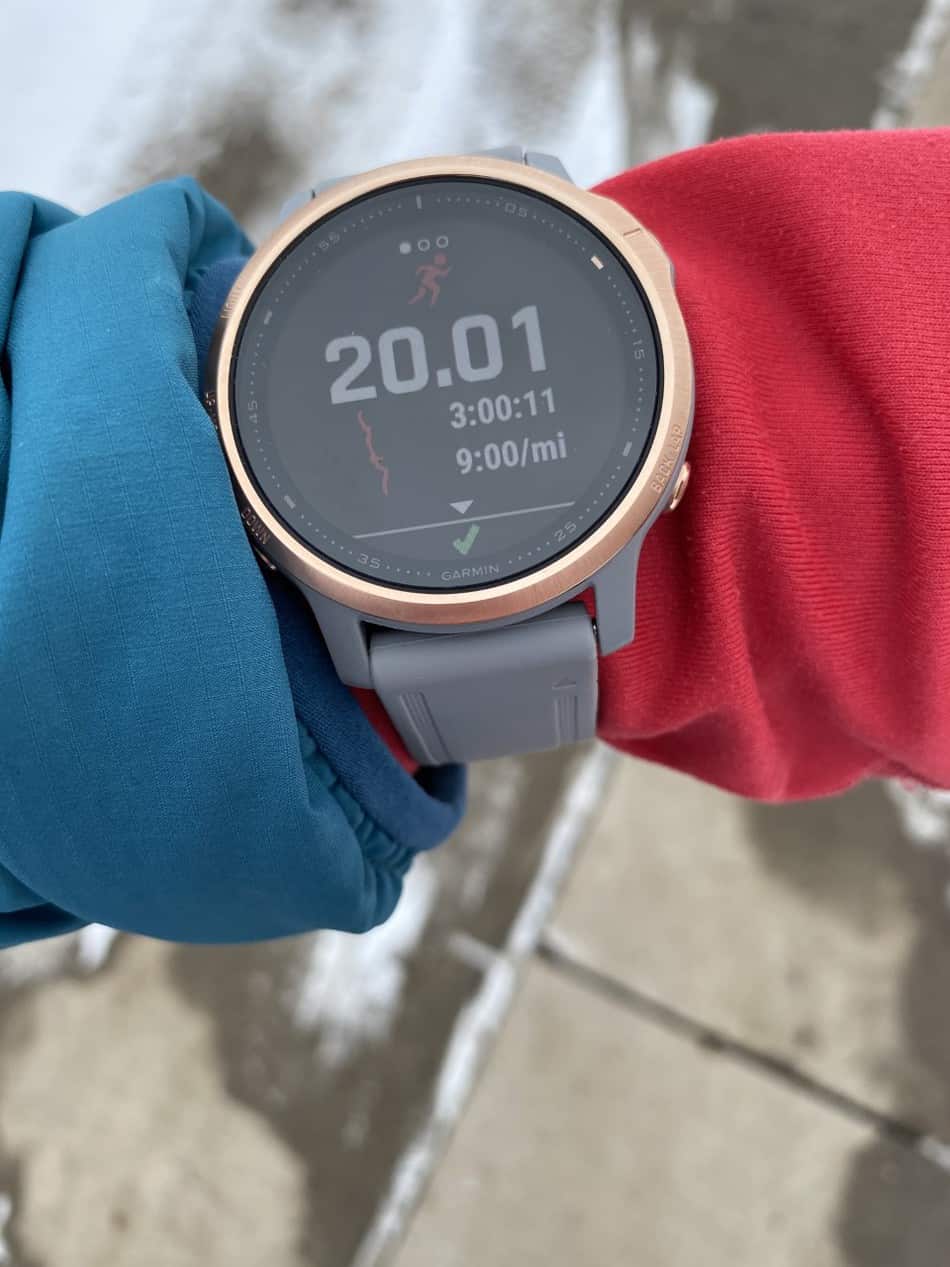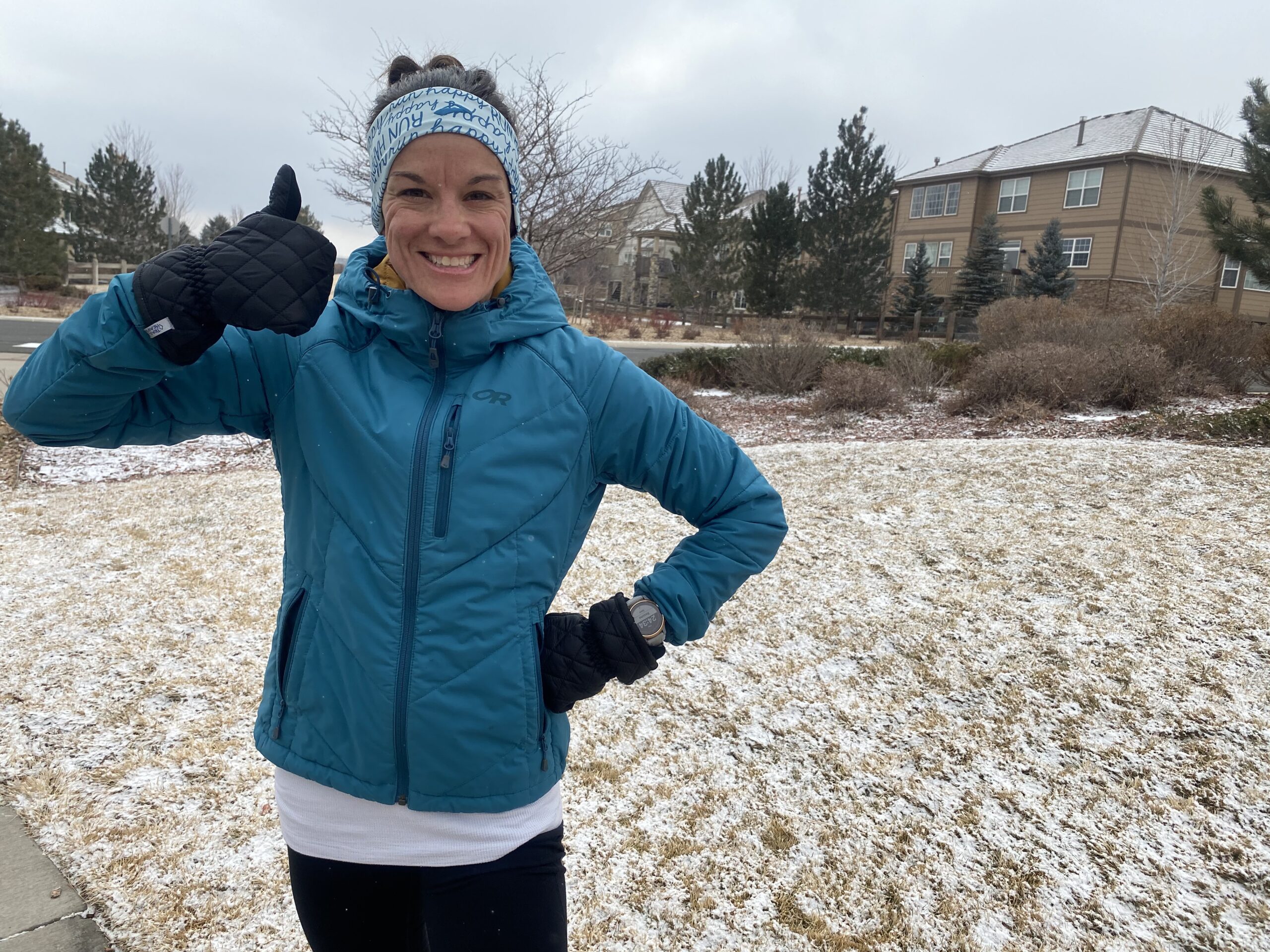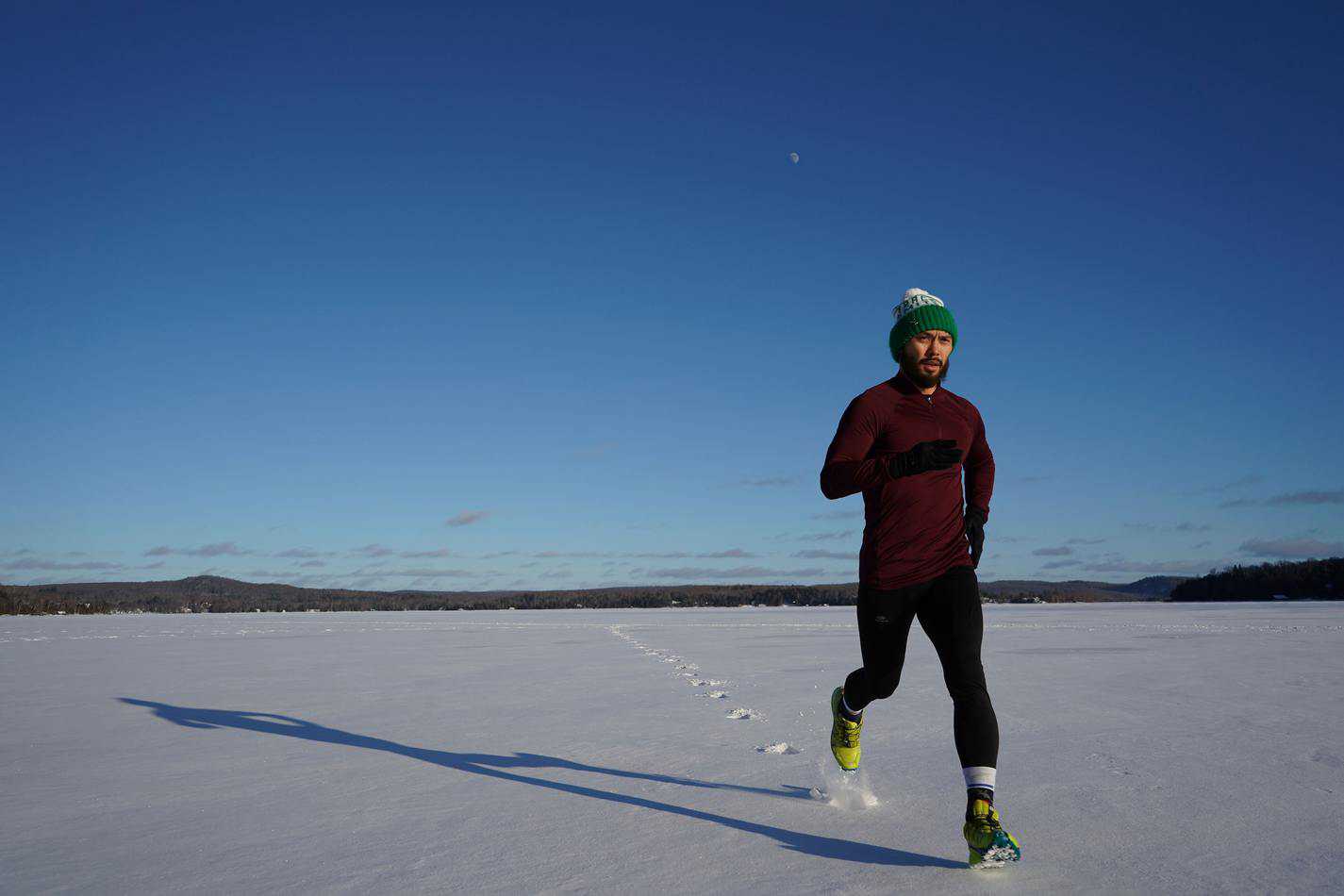I had never trained for a marathon in the winter until I was basically forced to. Okay, no one forced me to, but if I wanted to run the Boston Marathon (my dream race I’d worked so hard to qualify for), I was going to have to train through Colorado’s coldest months. There was a learning curve, but I learned strategies to properly train for a marathon during the frigid winter and you can, too.
Training for a marathon in winter is all about preparation. That means preparing yourself with the right layers to keep you warm as well as mentally preparing yourself to get through the mileage even when it’s bitter cold. There are other creative ways to stay motivated.
We’ll cover these as well as other great tips to get you through your winter marathon training in a way that, dare I say, I think you’ll even enjoy.
Considerations for Winter Marathon Training
Before I go over my top tips that helped me get through winter marathon training successfully (that I know will help you, too), let’s talk a little bit about what to consider as you move into all that cold weather running.
I mean, of course you’re saying to yourself, duh, it’s going to be cold. But obviously this depends a lot on where you live. And what’s cold to a Floridian is not going to be the same for someone who hails from Minnesota. Coloradoans (that’s me!), experience of cold and snowy days, but we also have our fair share of sunny days in the 50s.
But I think what most of you are concerned about when it comes to marathon training (at least I know it was for me) are those days where it’s below freezing, snowing, icy, spitting down freezing rain…often a combination of those!

So what you’ll want to consider for winter running is this:
- temperature – consider what your threshold is for running outside as everyone’s is different. If it’s absolutely too cold (even with all of your proper gear on), then you’ll need to have a plan for what those inside days will look like
- precipitation – if it’s snowing but there isn’t much sticking to the ground, I consider this to be an excellent running day! That means it’s not too cold and I won’t slip on any ice. Bundle up and get ‘er done! Freezing rain on the other hand or blowing snow that’s piling up is probably a day to take your run inside.
- ice on the ground – So I had a handful of days last year where it was a great day to run outside (in my opinion) yet there were still patches of ice here and there. This is where your common sense comes in. If you know you have great shoes for running on ice and snow (I have a great list here) and you know you can easily maneuver around the patches (or you are TRULY willing to walk over the carefully) then it sounds like and outside day. But just be extra careful as you might run into black ice and even the most dexterous person might find themselves flying through the air when they didn’t see it coming.
- wind – oh that biting wind is the worst! I had a 21-miler last year where the wind was just brutal…and the only thing exposed was my face! Wind chill can bring down real feel temperatures fast (a cold 20-degree day can become a very cold 9-degree day with even just 10 mph hour winds). The Weather Service offers this awesome chart to ensure you’re staying in the safe zone (provided you’re dressed correctly, too). Even in the “safe” zone, however, I personally would steer clear of anything that puts me in the one-digits or less category. There’s no reason to risk it or be that uncomfortable anyway.
With all that said, if you want to train for a marathon in the winter, you’re going to have to brave the cold, wind and snow some days. I have some the tips to make it easier on you while also ensuring you have a way to get those runs in when the weather truly is too frightful to bear.
9 Cold Weather Running Tips to Survive Winter Training
Though it’s ok to skip a day here and there in marathon training, it really is best to stick to your schedule unless there just is no way to get your run in. It does happen, but I’ll do anything I can to make it work and save “my days” for a sickness or little niggle that might sideline me for a few days.
Honestly, the weather really isn’t an excuse unless it puts your safety in jeopardy to either be running outside or driving on the roads to get to the gym. In that case, you’re off the hook. But let’s talk about how you can be sure to stick to your training plan even when it’s chillier than you’d prefer.
1.) Utilize the Treadmill or and Indoor Track (But Don’t Get Too Attached)
Though I usually prefer to run outdoors, I’m really thankful to have a treadmill!
RELATED: Advantages and Disadvantages of Training for a Marathon on a Treadmill
Whether I have a sick kiddo home from school, just want to get my easy run done in front of the TV, or the weather makes it too dangerous to run outdoors, utilizing the treadmill will ensure that you don’t miss a beat.
Don’t have a treadmill? You can head to your local gym to use one. Many gyms also have indoor tracks.
If you have a longer run on your schedule, the treadmill can get kind of boring. I’ll be honest – 10/11 miles on the treadmill is about my max before I start going a little cuckoo. One trick I like to do at the gym is run a couple of miles on the treadmill, hop off, and then run a mile or two on the track. Then back to the treadmill. It just serves to break things up a bit and I think you’ll find that your run goes by faster doing it this way.
I will just say, too, that there are some well-rated and pretty inexpensive treadmills out there if you don’t want to have to go to the gym to use one. Having one can make a big difference in a successful marathon training cycle (especially during the winter!)

All that said, DO NOT use your treadmill as a crutch. Your marathon is going to be outdoors which means you want to be training outside as much as possible. Even if it’s cold and snowy, as long as it’s safe to run outside, most of the time you should. This also helps with your mental training which we’ll talk about next.
2.) Focus on Building Your Mental Strength
A big reason you don’t want to get too attached to your treadmill is because of the mental strength you’ll build by forcing yourself out into the cold to get your run done. Though I would agree that completing long runs on a treadmill takes a certainn amount of mental strength, too, it’s also kind of a cop-out. (Not judging you…I do it, too. There have definitely been days I go for the treadmill when outside would be the better choice.)
Instead, push yourself to get out the door as long as the conditions will allow it.
Running a marathon takes extreme physical endurance, but the mental capacity it requires to keep willing yourself to run all the way through the finish line is immense. This is the perfect time to hone the skill pushing forward even when every fiber of your being wants you to stop.
3.) Join a Running Group to Hold Yourself Accountable
I cannot tell you how important this can be for so many runners when trying to maintain a running schedule during the winter. I am a pretty serious runner and I still have a very hard time pulling myself out of warm bed to go do a run in below-freezing temperatures. If you have a hard time staying motivated, those cold long runs are going to be tough to get done on your own.
Though I love my alone running time a lot, a group in these situations helps so much. Why?
- They’re counting on you to be there. You can try to convince yourself otherwise, but they want you there! And it’s not fair for the others to show up and you don’t and you know this…which means you’ll be that much more likely to pull yourself out of bed and meet up with your running buddies.
- The time goes by faster. Every time I run with friends it always feels like we did so many fewer miles than we actually do. Easy runs where you can chat away the miles are some of the best, and on a cold day, this is exactly what you need.
- It’ll help you forget you’re cold. Again, being able to talk to someone during a freezing run will help you keep your mind on something else instead of focusing on the cold.
This can be as simple as meeting up with even a friend or two, or joining a local training group in your area.
4.) Be Willing to Flex Your Schedule
Once you get into marathon training, it’s hard not to become a slave to the schedule. Though you can’t get too flexible with your training (you might end up injured, not get in enough miles, etc.) sometimes you have to amend it a bit to make it all work. Here’s what to do if you find that bad weather is putting a damper on your run.
- Switch Your Day Off – Ok, so I DID say that you shouldn’t take a day off unless absolutely necessary. But if you’re able to flex your schedule in a way that gets around you having to go out in the crazy weather (either on your feet or in your car), you could still take that day off and then run on your schedule off day. Because generally, I don’t advise athletes to run every day of the week anyway (read more about that here.)
- But this can also be a little tricky. If you had a speed workout scheduled for that day, don’t try to push it into your originally scheduled off day. That’s because you will probably end up with back-to-back “work” days and that could set you up for injury. Instead, just focus on getting the same mileage for the week and then you’ll be back to speedwork the following week. No big deal.
2.) Trade days so your long run or speed work can get done outside – The other way to flex your schedule is this. Let’s say the day you’re supposed to do your hard workout is the day that the weather is downright terrible. In that case, look at your schedule (or ask your coach) to see what you could switcheroo. So, in this option, you’re still running today, but taking it to an indoor track or treadmill instead for an easy paced run. Not because you can’t do speed work on a treadmill but you may not want to. Like, I would prefer to do a medium long run on my treadmill and do my speedwork outside on the day where it’s forecasted to be nicer.
When flexing your schedule, you don’t want back-to-back hard days (which includes any speed, tempos, medium long runs or long runs) and there should always be a recovery day inbetween as written about here.

5.) Familiarize Yourself with Ice-Free Zones
Training for a marathon through the winter likely means there are going to be some days where there’s ice on the ground. Now if there are sheets of ice, this day would probably fall into the category of “better to keep the run indoors.” But a little bit of ice doesn’t necessarily need to derail your run.
Instead, take note of areas that are completely or mostly free of ice patches. Roads that are always plowed on time, dirt trails or areas in full sunlight are the best places to go. The paved trail closest to my house is well-maintained all winter long and I also have the option to run alongside it in the dirt if I come across any ice patches. I bet you have something similar near you, as well.
6.) Stay Motivated By Signing Up for a Mid-Cycle Race
Since you’ve come here seeking advice for marathon training in the winter, I’m going to assume the marathon is your “A race.” Meaning, every point of preparation from now until race day is to get you across that finish line in the best way possible. But that doesn’t mean that you can’t plan a shorter race in the middle of the season to stay motivated.
Marathon training is tough enough in the best conditions and the last thing you want is to get burned out. Having a “B race” or even “C race” that helps keep you excited and your legs amped up is a great idea for winter marathon training.
Just remember that just because you sign up for one of these races doesn’t necessarily mean you need to go all out. If the timing to do so works out in your plan (like it’s at least a month out from race day) you can be a bit more aggressive. But if you already have a lot of speed on your schedule or have a fear of being sidelined from soreness, it would be a wiser choice to instead race your half marathon at your marathon goal pace instead. Plus, that can build a lot of confidence for you, too.
7.) Don’t Look at Your Watch on the Coldest Days
A drop in athletic performance starts as soon as temperatures fall below 50 degrees, and becomes noticeable once it becomes colder than freezing (32 degrees). Healthyway writes, ‘colder temps will also slow down the nervous system, causing fewer muscle contractions in your legs, which ultimately reduces your pace, slowing you down noticeably.”
Because of this, I recommend not looking at your watch. Start it when you start your run and then cover it with those long sleeves and gloves until it’s time to hit stop at the end of your run. Why? When it is that cold, there is no reason to focus on pace.
On the coldest days, I recommend making it an easy day, but if you really need to fit your speed work in, you can still do it without looking at your watch. If you do, you’re just going to get frustrated that you’re not hitting the paces you think you should be. Running by feel works much better in these situations.
8.) Complete Dynamic Stretching Inside Pre-Run
Getting warmed up for a run via dynamic stretching is a great way to activate your muscles and joints no matter what time of year it is. Things like leg swings (back and forth then side-to-side), high knees, butt kicks, and arm circles. Normally I do these as soon as I get outside, but on a cold winter day, I do them inside before I head out.
Even though I’m not working that hard doing these, it’s still getting my blood flowing and increasing my heart rate. In turn, my body is literally warming up. Not only is my body already warmer as I head out the door, but I also do waste time in the cold and I can get started on my run straightaway.
If you’re not sure what I mean by dynamic stretching – think movements that loosen up your body (NOT static stretches that you hold.) Lunges, leg swings (side-to-side and forward and backward), high knees – do what feels natural and feels good to you!
9.) Prepare With Winter Running Gear
Read on or watch my YouTube video below to find out all my favorite running gear for winter running!
So I saved this one for last because, duh, you already know you can’t wear your typical running clothes when it’s cold outside. But what you might not know is everything you’ll want to wear to make the run safe and enjoyable. And if you have a long run on your schedule, you need to know that you’re going to be freezing when you’re 10 miles away from your car, ya know?
Obviously you’ll need to flex some of these items depending on the elements. Layers are great, and as long as you have pockets, you can easily remove things like gloves or an ear-warmer if it starts making you too hot mid-run.
For Chilly Runs:
Chilly days between 30 and 40 degrees call for the right gear, but don’t require you to make drastic changes to your attire.
Here’s what I find works best:
- Long-Sleeve Top or a half-zip with a tank underneath (thumbholes are a big bonus) – Here a couple of mine and my husband’s favorites for women and men. Be sure to put your GPS watch over your sleeve if you want to be able to look at it!
- Compression Leggings or Tights (can be worn with or without shorts over)
- Merino Wool Blend Socks that cover the ankles – I love Smartwool but there are lots of choices
- Ear Warmer
- Thin gloves – inexpensive little gloves are perfect at this temperature, and it’s always nice if they have touch-screen capability, too.
Getting Colder Runs:
Once the temperature drops down under 30 degrees (or real feel is less than that due to the wind chill) but are still above 20, it’s time to add another layer. In addition to the long sleeve tops and leggings/tights, consider adding the following:
- Down Vest – I never knew how much I needed one of these until I started training for the Boston Marathon through the winter. I got this Patagonia vest for Christmas one year (as more of a fashion piece) and if I had to pick the most important piece of winter running gear I own, this would be it. There are also lots of great budget choices on Amazon.
- Knee socks – You can stick with the Merino wool, but knee socks will keep you a bit warmer.
- Warm Hat – According to the National Weather Service “at least half of your body heat is lost if your head is not covered.” So on the coldest days the ear warmer won’t do and you need to opt for a beanie that covers both your head and ears. Merino Wool is a great choice.
- Convertible Gloves/Mittens – Love these. I have a confession – I use my husband’s Saucony pair and they are way too big, but I use them over my North Face gloves for the coldest runs because they keep my hands so warm. Mittens keep hands warmer than gloves!
RELATED: 7 of the Best Running Gloves and Mittens for Cold Weather Running
For the Coldest Runs:
Once the temperatures dip below 20 degrees, you want to take care to plan your outfit to make sure you stay warm enough throughout your run. Here your outfit will consist of the layers mentioned above (you may want to wear a tank plus a long-sleeve top over) and then add on the following:
- Waterproof or water-resistant Insulated Jacket – This will replace the vest on less chilly runs. Consider a hood as that will give you the option for more head warmth if necessary. My jacket is the Outdoor Research Refuge (and here is the men’s version). It’s perfect for the coldest days of Colorado winters.
- Neck Gaiter – I have gotten several of these for finisher’s swag at races – you don’t need anything fancy to keep you warm!
For Icy or Snowy Runs:
Snow and/or ice on your run require you to be strategic with your shoe choice in order to stay safe. Follow the guidance above to determine your outfit based on the temperature and add the following:
- Shoes specifically designed for snow and ice running – we have a post on our favorites here. You may also opt to use something like Yaktrax that can be placed over your everyday running shoes.
- Waterproof Hooded Jacket – Insulated is best for colder weather or you can opt for something more lightweight if you have enough layers underneath – find my favorites here.
- Waterproof socks or shoe gaiter (optional) – if there is no risk of moisture getting in your shoes you can skip these
And, remember, if you’re going to be running for more than an hour, you should have water with you. Yes, even if it’s cold. A great tip is to fill your water carrier with warm water or your favorite electrolyte drink warmed up. This will make you more likely to actually drink it on the run! Read “Finding the Best Water Carriers for Runners” to find out the best way to carry water for both shorter runs and longer ones. A hydration vest also makes for a great place to stow layers if needed.
As I said, everyone has a different tolerance for what they can handle when it comes to the cold. A little trial and error and you’ll find what outfit works best for those cold or inclement weather runs.
Go Get Your Winter Marathon Training On
Hopefully, by now, you’re realizing that winter marathon training doesn’t have to be a drag if you plan accordingly. Though it can be a bit more challenging to navigate this season for training over the rest, there can be a lot of beauty (literally!) running all the miles this time of year. It may take a week or two to adapt, but if you dress appropriately and follow my tips, there’s no reason you can’t be successful training for a marathon in the winter.









